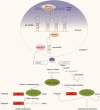Micro-ribonucleic acids: potential noninvasive biomarkers for hepatocellular carcinoma
- PMID: 27508173
- PMCID: PMC4918264
- DOI: 10.2147/JHC.S44463
Micro-ribonucleic acids: potential noninvasive biomarkers for hepatocellular carcinoma
Abstract
Hepatocellular carcinoma (HCC) is one of the most common malignancies globally. Each year, more than 500,000 people worldwide are diagnosed with HCC. The onset of HCC is typically unnoticeable, and the prognosis is usually poor. The early diagnosis of HCC and dynamic monitoring of this disease can contribute to more effective therapeutic interventions and improve patient outcomes. To achieve early diagnosis, more sensitive, specific, and easily detectable biomarkers are necessary. Recently, scientists have focused on identifying novel, sensitive, and minimally invasive or noninvasive biomarkers. Micro-ribonucleic acids (miRNAs) are a class of endogenous noncoding single-stranded RNAs that regulate gene expression at the posttranscriptional level. By negatively regulating target-gene expression, miRNAs play a critical role in diverse biological processes, including apoptosis, proliferation, differentiation, and developmental timing. Unique changes in miRNA expression in serum or plasma samples from HCC patients have been reported, suggesting that miRNAs may serve as novel noninvasive biomarkers for diagnosing HCC and evaluating therapeutic responses or as potential therapeutic targets in HCC. This review focuses on recent progress in understanding the role of miRNAs in HCC pathogenesis and progression, and highlights their diagnostic and prognostic value for HCC patients.
Keywords: biomarker; diagnosis; hepatocellular carcinoma; miRNA; prognosis.
Figures

Similar articles
-
Role of miRNA sponges in hepatocellular carcinoma.Clin Chim Acta. 2020 Jan;500:10-19. doi: 10.1016/j.cca.2019.09.013. Epub 2019 Oct 8. Clin Chim Acta. 2020. PMID: 31604064 Review.
-
Circulating microRNAs as diagnostic and prognostic tools for hepatocellular carcinoma.World J Gastroenterol. 2015 Sep 14;21(34):9853-62. doi: 10.3748/wjg.v21.i34.9853. World J Gastroenterol. 2015. PMID: 26379392 Free PMC article. Review.
-
MicroRNAs in the Pathogenesis of Hepatocellular Carcinoma: A Review.Cancers (Basel). 2021 Jan 29;13(3):514. doi: 10.3390/cancers13030514. Cancers (Basel). 2021. PMID: 33572780 Free PMC article. Review.
-
miRNAs: new tools for molecular classification, diagnosis and prognosis of hepatocellular carcinoma.Hepat Oncol. 2014 Jun;1(3):323-329. doi: 10.2217/hep.14.9. Epub 2014 Sep 9. Hepat Oncol. 2014. PMID: 30190966 Free PMC article. Review.
-
miRNA and lncRNA as potential tissue biomarkers in hepatocellular carcinoma.Noncoding RNA Res. 2023 Oct 24;9(1):24-32. doi: 10.1016/j.ncrna.2023.10.010. eCollection 2024 Mar. Noncoding RNA Res. 2023. PMID: 38075204 Free PMC article. Review.
Cited by
-
The miR-125a/HK2 axis regulates cancer cell energy metabolism reprogramming in hepatocellular carcinoma.Sci Rep. 2017 Jun 8;7(1):3089. doi: 10.1038/s41598-017-03407-3. Sci Rep. 2017. PMID: 28596599 Free PMC article.
-
Matrix stiffness-dependent STEAP3 coordinated with PD-L2 identify tumor responding to sorafenib treatment in hepatocellular carcinoma.Cancer Cell Int. 2022 Oct 13;22(1):318. doi: 10.1186/s12935-022-02634-7. Cancer Cell Int. 2022. PMID: 36229881 Free PMC article.
References
Publication types
LinkOut - more resources
Full Text Sources
Other Literature Sources

